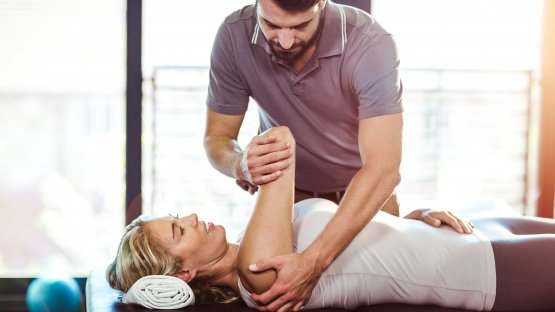How Physiotherapy Can Help With Parkinson's Disease?
Parkinson's disease is a neurodegenerative disorder that can cause the motor and non-motor signs such as cognitive impairments. Although there isn't a permanent solution to Parkinson's, surgeries, drugs, and other treatments are utilized to treat the symptoms. For most patients with Parkinson's disease, a different treatment option, such as physiotherapy, is needed to improve mobility and increase independence. Any type of exercise is beneficial to those who have Parkinson's disease.
A physiotherapist can help the patient learn the proper movements to increase flexibility, strength, and balance and assist them in remaining in a healthy and independent state. In this article, we've examined physiotherapy treatment for people with Parkinson's disease. Below are the advantages and exercises a well-trained physiotherapist employs to control these symptoms.
What is Parkinson's Disease?
Parkinson's disease results from conditions of the basal ganglia, an area of neurons found deep in the cerebral hemispheres. The symptoms include rigidity, which is characterized by increased resistance and shaking in the state of rest. Parkinson's disease can be caused by dopaminergic cell degeneration within the substantial nerve and is caused by environmental and genetic causes.
The benefits of physical therapy
The primary function of a professional physiotherapist is to improve the strength of the functional capacity, endurance, flexibility, fitness, and balance by assisting in the rehabilitation of movement and education. The physiotherapy treatments include exercises and instruction in the movement strategy.
- Maintains a healthy breathing pattern,
- Improves joint strength and muscle flexibility.
- Corrects and improves posture and movement patterns.
- Maintains and enhances functionality as well as independence. This aids in improving the level of living.
Management of physiotherapy
The physiotherapist extensively assesses posture, strength, flexibility, walking coordination, endurance, balance, and concentration on the movement. Based on the test results, the physiotherapist devises an exercise routine to ensure you are as active and self-sufficient as possible.
By the severity and nature of the disease, a treatment plan is developed that is based on exercises and patient education. The program consists of exercises that aid in:
- Strengthen your fitness, improve strength and flexibility
- More easily turn over in bed,
- Get into and out of chairs, beds, and automobiles,
- More easily turn over in bed,
- Turn, stand, and switch directions more efficiently,
- Improve your coordination and smoothness while walking.
- Increase hand movements.
- Enhance the capacity to ascend and lower stairs, curbs,
- Do two tasks at the same speed that is more efficient,
- Engage in important activities.
Exercise has been found to improve well-being and health in Parkinson's patients. Exercises for neuroprotection focus on endurance and using motor learning techniques like dual-task and mental imagery. It requires complex, effective and rigorous exercises. Training in neuroprotection is highly effective and should be introduced at the beginning stages. Still, it can be beneficial at any stage.
Aerobic training
Aerobic exercise can slow down depression and degeneration of motor skills. Also, it improves living quality for people who have Parkinson's. Exercises that aim to improve cardiopulmonary functioning and the biomechanics of posture, biomechanics, and general symmetrical movement have been shown to benefit neurodegenerative disorders significantly.
Exercises for breathing
Breathing exercises, such as inspiratory muscle training to improve lung function for patients with mild to moderate Parkinson's, have proven efficient. The respiratory complications are seen in many patients as their Parkinson's worsens. Therefore, attention should be given to managing the respiratory muscles' gradual weakness and the thoracic girdle's rigidity. Patients are encouraged to keep active and to engage in physical activity for as long as possible.
Exercises in range of motion
To treat both motor and non-motor signs, the correct and appropriate motion is accomplished by increasing the range of motion and physical endurance in daily routines by walking and including manual tasks like grasping, holding, etc.
Exercises to strengthen
Exercises for strengthening are performed against an external force, such as weight machines and weight cuffs. They can also be used for cycling ergometers, therapeutic putty elastic, etc. This improves balance and overall physical performance and balance. Since muscle weakness is a significant issue for people with Parkinson's disease, the physiotherapist suggests resistance exercises using light dumbbells and resistance bands based on what stage the illness is at. Hydrotherapy or water resistance is also a great way to build muscles.
Stretching and Flexibility
Patients with Parkinson's disease tend to experience tightness in the hip and muscles of the calf, etc. To reduce stiffness, stretching exercises regularly throughout the day are recommended.
Balance Work
Normal balance is an interaction between the visual feedback system and the inner ear that helps to orient the feet and detect the surface beneath them. Parkinson's disease can alter the equilibrium system and make gait unsteady. Training your gait can help increase balance. Psychotherapy blends cognitive strategies and cueing techniques in balance exercises and physical exercises. Direct effects of external cueing and focus can be observed in the improvement of step length, freezing, and turning while walking and other everyday activities.
To provide a patient-focused treatment, it is essential to offer information to the patient, talk about the options and engage in an engaging session. Effective communication and the ability to educate the patient are essential when delivering an intervention.




Comments
Post a Comment